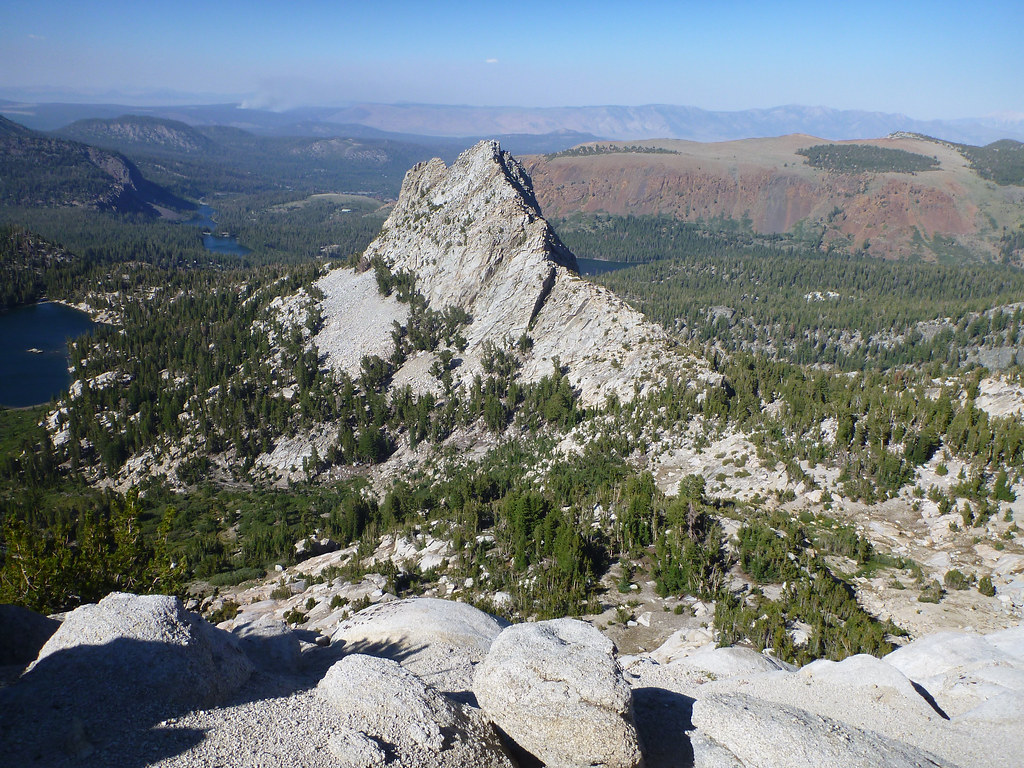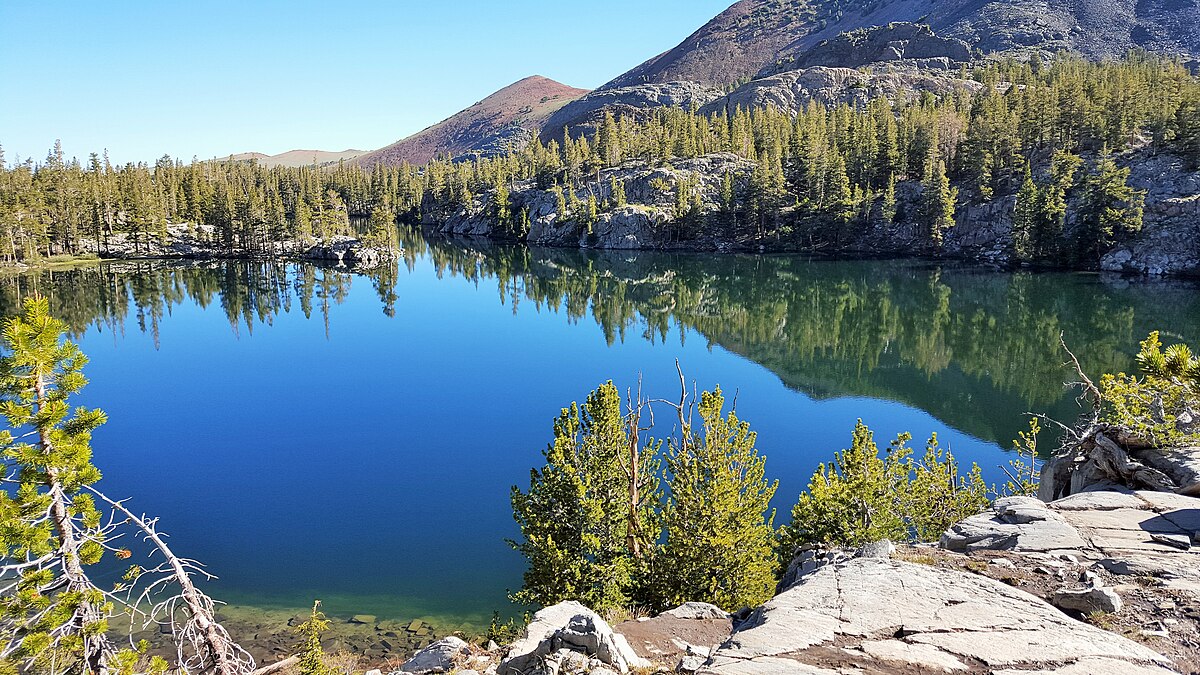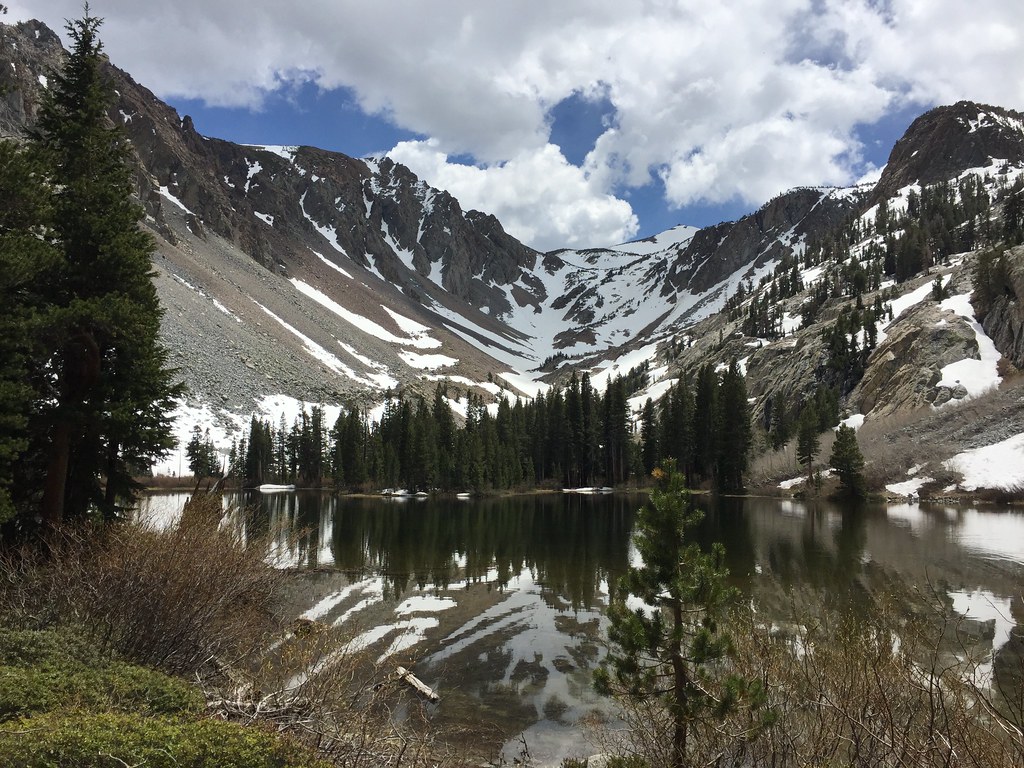Maybe you’re already a fan of some of our area’s more mild hikes, such as McCleod or the Panorama Dome but are looking for more of a challenge for your next trip to the mountains! The good news is, the Eastern Sierra is happy to oblige—and reward the extra effort with some incredible sights!
Take a look at these 8 moderate to hard hiking trails to try the next time you’re in Mammoth Lakes!
Deer Lakes Loop
Rating: Hard
Distance: 12.9
Elevation Gain: Just over 3,000ft
Time: About 7 hours

The Deer Lakes Loop is a just-shy-of-13 mile hike that starts at Lake George in the Lakes Basin. The first stretch tends to be a bit crowded (and very steep!), but the views of Lake George, Lake Mary and Crystal Crag are stunning. Once you reach Crystal Lake, the crowd will thin out and you’ll get to enjoy the quieter side of the backcountry while hiking along the iconic Mammoth Crest.
Hikers not familiar with the area are recommended to download a trail map, as the trail can become a bit hard to find between Deer lake and Duck Pass.
Steelhead Lake via McGee Pass Trail
Rating: Hard
Distance: 11.1 miles
Elevation Gain: 2,522 ft
Time: About 6 hours
This out-and-back adventurous trek features a few steep inclines, various river crossings, and some of the best wildflower meadows in the area. It is a popular trail for pack teams at least for the first few miles, but even if you run into some horseback riders, it’s one of the quieter hikes you’ll find in the Eastern Sierra!
A couple of things to keep in mind is that this hike tends to be quite buggy and wet. River crossings should always be done safely and there may be areas where you’ll need to traverse hard-packed snow, which can be slippery. Hikers recommend hitting the trail early as things become shady, chilly, and difficult to see as soon as the sun dips below the mountains in late afternoon.
Skelton Lake Loop
Rating: Moderate
Distance: 3.4 miles
Elevation Gain: 859 ft
Time: About 2 hours

If you’re looking for a shorter, picturesque hike with plenty of lakes, streams, meadows, and peak views, Skelton Lake Loop should definitely be your go-to! It offers plenty of shade and a good variation of terrains to keep you engaged.
Skelton Lake Loop starts and ends at the Duck Pass trailhead located behind Coldwater Campground. The first portion features some dusty switchbacks, but once you get past the initial incline, you’ll be treated to three gorgeous lakes!
Seven Lakes Point via Dragon’s Back Trail
Rating: Hard
Distance: 5.5 miles
Elevation Gain: 2,352 ft
Time: About 4 hours
It may be one of the shorter hikes on our list, but don’t underestimate this challenging trek! The trail features a steep incline that will take you above the treeline, and once you’re up there, you’ll get some of the best views of the Lakes Basin and Owens Valley. This hike starts at Twin Lakes and takes you straight up to the top of Mammoth Mountain.
A few things to keep in mind is that this can be a pretty popular trail, so get ready to share the wilderness with other hikers! There are also a few areas with loose footing, so make sure to wear appropriate shoes. Because much of the trek takes place above the treeline, you’ll want to be prepared for intense sun and wind exposure.
Valentine Lake via Sherwin Lakes Trail
Rating: Hard
Distance: 9.7 miles
Elevation Gain: 1,919 ft
Time: About 5 hours
Although it is considered a hard hike, the trip up to Valentine Lake is popular among locals and visitors alike. The out-and-back trail starts at the Sherwin Lakes Trailhead and takes you into John Muir Wilderness, first past Sherwin Lakes and then up a steep incline to Valentine Lake. (Want a moderate version of this hike? Make Sherwin Lakes your turnaround point!)
The last mile is typically considered the hardest, but it’s worth it to see Valentine Lake, which is a popular spot for swimming, fishing, and camping. Unfortunately, this area can get quite buggy, so you’ll need to be ready to face the mosquitoes!
Parker Lake
Rating: Moderate
Distance: 3.6 miles
Elevation Gain: 646 ft
Time: About 1 hour and 45 minutes
This trail asks a lot of you right in the beginning as it starts out with some moderately steep inclines in pure sunshine and sagebrush. But, once you get through it, you’ll be treated to one of June Lake’s most beautiful creekside trails. This area is known for its gorgeous wildflowers and aspens, and of course Parker Lake at the end of the trail is a pristine, clear lake that is great for a dip before heading back down.
Trailhead parking is located on a dirt road, so you’ll want to make sure your car can handle the terrain. And, this is one of the more popular hikes in the June Lake Loop so be prepared for a busier trail than some of the other options on our list!
Fern Lake
Rating: Hard
Distance: 3.2 miles
Elevation Gain: 1,555 ft
Time: 2.5 hours

The trail up to Fern Lake is a straight, somewhat unforgiving incline that can be a bit technically challenging thanks to rocky terrain. But, if you can stick with it (and maybe bring some hiking poles), the reward at the top of the trail is truly stunning!
There’s also plenty of shade to keep you cool and a nice rest stop where the trail meets Fern Creek at the Yost Creek Trail split.
Thousand Island Lake via Rush Creek Trail
Rating: Hard
Distance: 14.3 miles
Elevation Gain: 3,884 ft
Time: About 8 hours
This is one of the most difficult hikes out of the June Lake Loop area, and is popular as a multi-day backpacking trip instead of a day hike (although it can be attempted as a day hike for ambitious folks.) The trail can be steep, rocky, and sun and wind exposed in some parts, but hikers agree that this is a beautiful trip that is well worth the effort.
Once you hit about 9,000 ft, you’ll be treated to gorgeous alpine meadows. That being said, it’s recommended that you go during July or August so that you’re not bogged down by snow at the higher elevations.
Keep your eye out for old mining equipment along this trail!
Tips on taking on moderate and hard hiking trails
Maybe you’ve done a few mild hikes up here in the Eastern Sierra and are excited to try something more challenging! Here are a few tips to make your big hikes more enjoyable!
-
Start early. That way you can set a slow pace without worrying about getting caught in the dark.
-
Bring reinforcements. Some tasty snacks, plenty of water, and exercise gels can be great in moments when you need an energy boost.
-
Pack bug spray and sunscreen with you. Applying before you hit the trail may not be enough to last through the whole hike. So make sure to carry bug spray and sunscreen in your bag.
-
Download the trail map. Some of the trails we’ve covered here have areas in which the trails aren’t clearly marked. Websites like Alltrails allow you to download maps so that you’re never worried about wandering off the route.
-
If you’re not sure how you’ll handle it, opt for an out-and-back trail. The benefit of an out-and-back trail is that you can turn around when you start to feel fatigued. It’s always better to call it before you reach the summit than risk injury or exhaustion. You can always try again!
-
Be ready for some good rest! No matter how active your daily life is, hiking at high altitude is a huge effort! So, when you get back to your condo at the end of the day, do some stretches, have a nutritious meal, stay hydrated, and get a good night’s sleep. That way, your muscles can recover for your next fun activity.
Here at Mammoth Mountain Reservations, we love to hear when our customers are excited about trying more challenging hikes! Let us know about your experience hiking in the Eastern Sierra and any questions you have about upping your hiking game!
